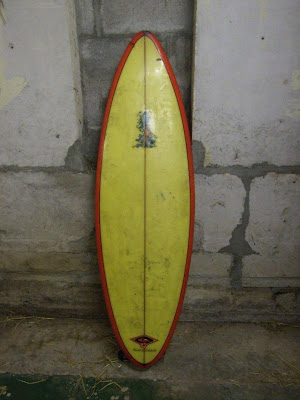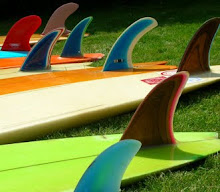Here's some random images I've been sent or have seen in the past few months. If I don't put them on now they'll be lost in the pile of emails like loads of other photos...
 Circle One snapped up by Alex just after christmas. Double hips, channels, five fin boxes -you name it, its got it ! This was on ebay as a buy it now for around 15 minutes.
Circle One snapped up by Alex just after christmas. Double hips, channels, five fin boxes -you name it, its got it ! This was on ebay as a buy it now for around 15 minutes.

 Newquay boards 1981, shot by John Conway. Think thats Martin Wright on the right with one of his Hot Stuff shapes for Vitamin Sea. Not sure who that is on the left in the superhero wetsuit but he's holding a Derek Hynd 'Newwave' Hot Buttered which might have been made by Mooney at Ocean Magic. Cool shot.
Newquay boards 1981, shot by John Conway. Think thats Martin Wright on the right with one of his Hot Stuff shapes for Vitamin Sea. Not sure who that is on the left in the superhero wetsuit but he's holding a Derek Hynd 'Newwave' Hot Buttered which might have been made by Mooney at Ocean Magic. Cool shot.
 Bilbo transitional '68.
Bilbo transitional '68.
 Bob and Julie Bushrod's vw, Canaries '78. Tigger Newling shape 2nd from right.
Bob and Julie Bushrod's vw, Canaries '78. Tigger Newling shape 2nd from right.
 with chops at Tris surfboards late 70s
with chops at Tris surfboards late 70s
 Danny West aka Garland (space gypsy)
Danny West aka Garland (space gypsy)
 Paul's transitional 'bat' surfboard , '67 ish. Anyone know anything about bat logo ?
Paul's transitional 'bat' surfboard , '67 ish. Anyone know anything about bat logo ?
 Pierre from France moving house
Pierre from France moving house
 Atlantic surf shop board apparently made in UK (I've not seen one of these before)-
Atlantic surf shop board apparently made in UK (I've not seen one of these before)-
 Circle One snapped up by Alex just after christmas. Double hips, channels, five fin boxes -you name it, its got it ! This was on ebay as a buy it now for around 15 minutes.
Circle One snapped up by Alex just after christmas. Double hips, channels, five fin boxes -you name it, its got it ! This was on ebay as a buy it now for around 15 minutes.
 Newquay boards 1981, shot by John Conway. Think thats Martin Wright on the right with one of his Hot Stuff shapes for Vitamin Sea. Not sure who that is on the left in the superhero wetsuit but he's holding a Derek Hynd 'Newwave' Hot Buttered which might have been made by Mooney at Ocean Magic. Cool shot.
Newquay boards 1981, shot by John Conway. Think thats Martin Wright on the right with one of his Hot Stuff shapes for Vitamin Sea. Not sure who that is on the left in the superhero wetsuit but he's holding a Derek Hynd 'Newwave' Hot Buttered which might have been made by Mooney at Ocean Magic. Cool shot. Bilbo transitional '68.
Bilbo transitional '68. Bob and Julie Bushrod's vw, Canaries '78. Tigger Newling shape 2nd from right.
Bob and Julie Bushrod's vw, Canaries '78. Tigger Newling shape 2nd from right. with chops at Tris surfboards late 70s
with chops at Tris surfboards late 70s Danny West aka Garland (space gypsy)
Danny West aka Garland (space gypsy) Paul's transitional 'bat' surfboard , '67 ish. Anyone know anything about bat logo ?
Paul's transitional 'bat' surfboard , '67 ish. Anyone know anything about bat logo ? Pierre from France moving house
Pierre from France moving house Atlantic surf shop board apparently made in UK (I've not seen one of these before)-
Atlantic surf shop board apparently made in UK (I've not seen one of these before)-''One of the first french surf shops was in BORDEAUX, open during the 75's and close in the area of 1990: it was the " Atlantic surf shop" 89 boulevard antoine gautier - 33000 Bordeaux.
The owner was Patrice CHRZAN, the man contribute also at the first organisation of LACANAU PRO surf competition in the 80's.
(LACANAU PRO winner 1981 :Wayne Bartholomew and 1989 Martin Potter...).
In the 70's french shaper were not very famous (exepted Michel Barland) and not a lot !!, so all the surfboard and the wetsuits we can find in the shop come from foreign country. Some from usa but large parts come from uk.Wetsuits for sale in the shop: gul, second skin, tiki and surfboards: sea shapes, ocean magic, free bird and "atlantic surf shop" surfboard (see the picture).
I recently found one, the first owner was a english man who bought it in uk and take it to france. others were for sell at the shop. i am sure they were shaped in uk and after delevery at the shop in bordeaux. The surfboard I bought was surely bought directly at the uk shaper or perhaps some were also for sell in uk...?
Now i am looking for the shaper (perhaps they were many, or the town it was shaped in), there is no other maker name on the surfboard thant the logo you see, no signature or number.
Perhaps can you find something....
regards and congratulation again for your website.
jean-pierre from Bordeaux - France.''
The owner was Patrice CHRZAN, the man contribute also at the first organisation of LACANAU PRO surf competition in the 80's.
(LACANAU PRO winner 1981 :Wayne Bartholomew and 1989 Martin Potter...).
In the 70's french shaper were not very famous (exepted Michel Barland) and not a lot !!, so all the surfboard and the wetsuits we can find in the shop come from foreign country. Some from usa but large parts come from uk.Wetsuits for sale in the shop: gul, second skin, tiki and surfboards: sea shapes, ocean magic, free bird and "atlantic surf shop" surfboard (see the picture).
I recently found one, the first owner was a english man who bought it in uk and take it to france. others were for sell at the shop. i am sure they were shaped in uk and after delevery at the shop in bordeaux. The surfboard I bought was surely bought directly at the uk shaper or perhaps some were also for sell in uk...?
Now i am looking for the shaper (perhaps they were many, or the town it was shaped in), there is no other maker name on the surfboard thant the logo you see, no signature or number.
Perhaps can you find something....
regards and congratulation again for your website.
jean-pierre from Bordeaux - France.''












































































